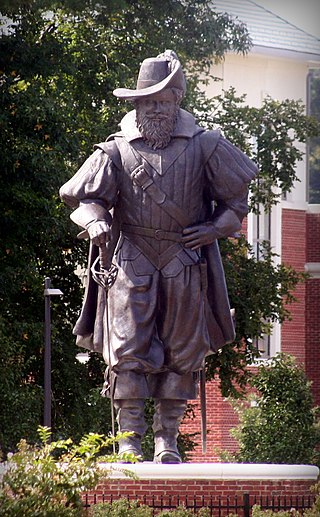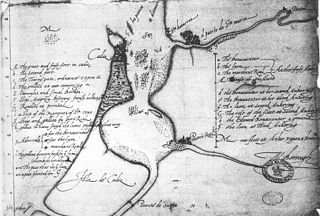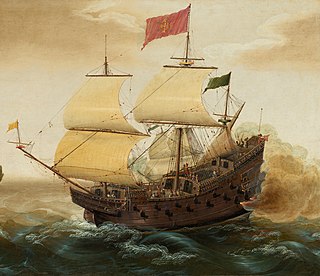Related Research Articles

A privateer is a private person who or a vessel that engages in maritime warfare under a commission of war. Since robbery under arms was a common aspect of seaborne trade, until the early 19th century all merchant ships carried arms. A sovereign or delegated authority issued commissions, also referred to as letters of marque, during wartime. The commission empowered the holder to carry on all forms of hostility permissible at sea by the usages of war. This included attacking foreign vessels and taking them as prizes and taking crews prisoner for exchange. Captured ships were subject to condemnation and sale under prize law, with the proceeds divided by percentage between the privateer's sponsors, shipowners, captains and crew. A percentage share usually went to the issuer of the commission.

Sir James Lancaster was an English privateer and trader of the Elizabethan era.

Christopher Newport (1561–1617) was an English seaman and privateer. He is best known as the captain of the Susan Constant, the largest of three ships which carried settlers for the Virginia Company in 1607 on the way to found the settlement at Jamestown in the Virginia Colony, which became the first permanent English settlement in North America. He was also in overall command of the other two ships on that initial voyage, in order of their size, the Godspeed and the Discovery.

Robert Searle was one of the earliest and most active of the English buccaneers on Jamaica.
Pieter Schouten was a 17th-century Dutch corsair and privateer. He was one of the first Dutchmen to explore to the Caribbean and, while employed by the Dutch West Indies Company, was involved in extensive reconnaissance to establish Dutch bases in the West Indies.

The Battle of San Juan de Ulúa was fought between English privateers and Spanish forces at San Juan de Ulúa. The English flotilla of six armed merchant ships under John Hawkins had been trading along the Spanish Main with the cooperation of local Spanish officials. However the central Spanish authorities considered this to be illegal smuggling that violated the Treaty of Tordesillas.

Singeing the King of Spain's Beard is the derisive name given to a series of attacks by the English privateer Francis Drake against the Spanish in the summer of 1587, beginning in April with a raid on Cádiz. This was an attack on the Spanish naval forces assembling in the Bay of Cádiz in preparation for the planned expedition against England. Much of the Spanish fleet was destroyed, and substantial supplies were destroyed or captured. There followed a series of raiding parties against several forts along the Portuguese coast. A Spanish treasure ship, returning from the Indies, was also captured. The damage caused by the English delayed Spanish preparations for the Armada by at least a year.

The Sea Dogs were a group of English privateers and explorers authorised by Queen Elizabeth I to raid England's enemies, whether they were formally at war with them or not. Active from 1560 until Elizabeth's death in 1603, the Sea Dogs primarily attacked Spanish targets both on land and at sea, particularly during the Anglo-Spanish War. Members of the Sea Dogs, including Sir John Hawkins and Sir Francis Drake, also engaged in illicit slave trading with Spanish colonies in the Americas.

The Battle of Pinos was a naval engagement between a Spanish fleet under Admiral Bernardino Delgadillo y Avellaneda and the surviving ships of Francis Drake's expedition to the Spanish West Indies, now in command of Drake's lieutenant, Sir Thomas Baskerville, which took place off the Island of Pinos during the Anglo-Spanish war of 1585. The Spanish squadron was victorious, capturing two English ships.

The Battle of Berlengas Islands was a naval battle which took place off the Portuguese coast on 15 July 1591, during the war between Elizabeth I of England and Philip II of Spain. It was fought between an English privateer squadron under George Clifford, 3rd Earl of Cumberland, who had set out his fortunes by large-scale privateering, and a squadron of 5 Spanish galleys commanded by Francisco Coloma tasked with patrolling the Portuguese coast against privateers. While anchored off the Berlengas, the English ships were surprised by the Spanish galleys, which succeeded in taking one English ship and rescuing two prizes.
The action of San Mateo Bay or action of Atacames Bay was a naval engagement which took place from 29 June to 1 July 1594 between the galleon Dainty under the command of English privateer Richard Hawkins and a Spanish squadron of three galleons commanded by Beltrán de Castro at the mouth of the Esmeraldas river, nowadays Ecuador.
The Raid on Puerto Caballos was a military event that took place during the Anglo–Spanish War where a small expedition of ships funded and raised by the Earl of Cumberland was sent to the Caribbean under command of Captain James Langton. At Puerto Caballos on the coast of the Royal Audiencia of Guatemala in the New World empire of Spain on 16 March 1594, Langton raided the place and after a three-day battle won possession of seven ships under command of Diego Ramirez along with much booty.

The Battle of Puerto Caballos was a military event during the Anglo–Spanish War to capture the Spanish town and port of Puerto Caballos on 17 February 1603 by an English fleet under Christopher Newport and Michael Geare. The English were able to achieve victory after a bitter fight. Two Spanish galleons were captured, one of which was subsequently burned. The Anglo-French consortium occupied the area and after two weeks withdrew with captured booty.
The Raid on Tabasco, Capture of Tabasco or Newport's 2nd Expedition of 1599 was an English military expedition during the Anglo–Spanish War that captured the Spanish port settlement of Tabasco in New Spain. The English under Christopher Newport then occupied the town and gained a significant amount of booty before heading home.

The Blockade of Western Cuba, also known as the Watts' West Indies Expedition of 1591, was an English privateering naval operation that took place off the Spanish colonial island of Cuba in the Caribbean during the Anglo–Spanish War. The expedition along with the blockade took place between May and July 1591 led by Ralph Lane and Michael Geare with a large financial investment from John Watts and Sir Walter Raleigh. They intercepted and took a number of Spanish ships, some of which belonged to a Spanish plate convoy of Admiral Antonio Navarro, and protected by the Spanish navy under Admiral Diego de la Ribera intending to rid English privateers. The English took or burnt a total of ten Spanish ships including two galleons, one of which was a valuable prize. With this success and the loss of only one ship the blockade and expedition was terminated for the return to England. The blockade was one of the most successful English expeditions to the Spanish Main during the war militarily and financially.

Watts' West Indies and Virginia expedition also known as the Action of Cape Tiburon was an English expedition to the Spanish Main during the Anglo–Spanish War. The expedition began on 10 May and ended by 18 July 1590 and was commanded by Abraham Cocke and Christopher Newport. This was financed by the highly renowned London merchant John Watts. The English ships intercepted and dispersed Spanish convoys capturing, sinking, and grounding many ships off the Spanish colonies of Hispaniola, Cuba, and Jamaica. Despite losing an arm, Newport was victorious and captured a good haul of booty. A breakaway expedition from this discovered that the Roanoke Colony was completely deserted and which gave the name The Lost Colony.

The Capture of Santiago de Cuba was a minor military event that took place towards the end of the Anglo–Spanish War in May 1603. Santiago de Cuba was attacked and sacked by English privateers led by Christopher Cleeve.

Francis Drake's circumnavigation, also known as Drake's Raiding Expedition, was an important historical maritime event that took place between 15 December 1577 and 26 September 1580. The expedition was authorised by Queen Elizabeth I and consisted of five ships led by Francis Drake. Termed a 'voyage of discovery', it was in effect an ambitious covert raiding voyage and the start of England's challenge to the global domination of Spain and Portugal.
This timeline of the history of piracy in the 1600s is a chronological list of key events involving pirates between 1600 and 1609.
Newport's 1592 expedition was a series of privateering attacks which took place between April to June 1592 on the Spanish Main, mostly on the island of Hispaniola between an English raiding force led by Christopher Newport and defending Spanish garrisons. The largest engagement too place at the town of La Yaguana. Newport then completed his expedition by raiding settlements and shipping in the Bay of Honduras before heading home without losing any ships.
References
- ↑ Fury, Cheryl A. Tides in the Affairs of Men: The Social History of Elizabethan Seamen, 1580–1603. Westport, Connecticut: Greenwood Publishing Group, 2002. (pg. 12–13) ISBN 0-313-31948-0
- ↑ Marley, David F. Historic Cities of the Americas: An Illustrated Encyclopedia. Santa Barbara, California: ABC-CLIO, 2005. (pg. 150) ISBN 1-57607-027-1
- ↑ James, Lawrence. Warrior Race: A History of the British at War. New York: St. Martin's Press, 2001. (pg. 165–166) ISBN 0-312-30737-3